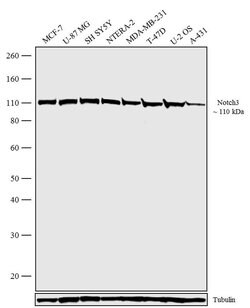Learn More
Invitrogen™ NOTCH3 Recombinant Rabbit Monoclonal Antibody (4H5L17)
Rabbit Recombinant Monoclonal Antibody
Supplier: Invitrogen™ 701975
Description
This antibody is predicted to react with Monkey, Bovine, Rat, Cat Recombinant rabbit monoclonal antibodies are produced using in vitro expression systems. The expression systems are developed by cloning in the specific antibody DNA sequences from immunoreactive rabbits. Then, individual clones are screened to select the best candidates for production. The advantages of using recombinant rabbit monoclonal antibodies include: better specificity and sensitivity, lot-to-lot consistency, animal origin-free formulations, and broader immunoreactivity to diverse targets due to larger rabbit immune repertoire.
NOTCH3 is the third discovered human homologue of the Drosophilia melanogaster type I membrane protein notch. In Drosophilia, notch interaction (with its cell-bound ligands delta, serrate) establishes an intercellular signalling pathway that plays a key role in neural development. Homologues of the notch-ligands have also been identified in human. NOTCH3 functions as a receptor for membrane-bound ligands Jagged1, Jagged2, and Delta1 to regulate cell-fate determination. Mutations in NOTCH3 have been identified as the underlying cause of cerebral autosomal dominant arteriopathy with subcortical infarcts and leukoencephalopathy (CADASIL).
Specifications
| NOTCH3 | |
| Recombinant Monoclonal | |
| 0.5 mg/mL | |
| PBS with 0.09% sodium azide; pH 7.4 | |
| Q9UM47 | |
| Notch3 | |
| Peptides corresponding to human Notch3 (aa2308-2321, 1618-1636, 1803-1816). | |
| 100 μg | |
| Primary | |
| Human | |
| Antibody | |
| IgG |
| Western Blot | |
| 4H5L17 | |
| Unconjugated | |
| Notch3 | |
| AW229011; CADASIL; CADASIL1; CASIL; hpbk; IMF2; LMNS; N3; Neurogenic locus notch homolog protein 3; notch 3; Notch 3 extracellular truncation; Notch 3 intracellular domain; Notch gene homolog 3; Notch homolog 3; NOTCH3 | |
| Rabbit | |
| Protein A | |
| RUO | |
| 4854 | |
| Store at 4°C short term. For long term storage, store at -20°C, avoiding freeze/thaw cycles. | |
| Liquid |
Your input is important to us. Please complete this form to provide feedback related to the content on this product.
